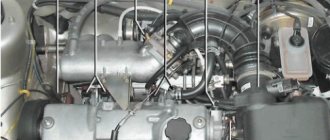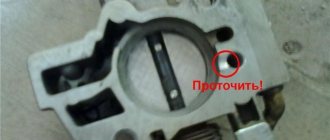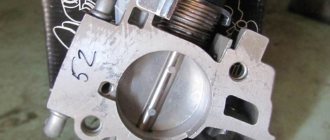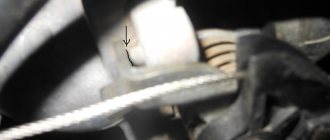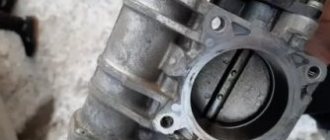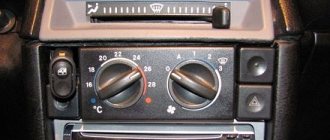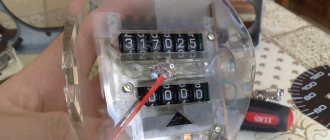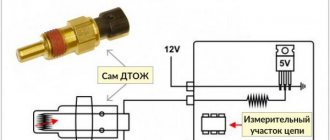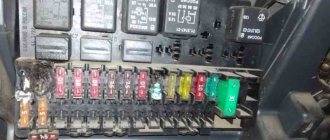Hello guys. The car is a VAZ 2114. This is the second time the throttle heating hoses have burst. Which ones would you recommend installing instead of the “factory” ones?. VAZ 2114 throttle valve heating hose.
Similar articles
25 comments on “Throttle valve heating hose for VAZ 2114. This is the second time the throttle heating hoses have burst”
Install the plant, it's a consumable
Had the same problem
Try to find reinforced ones, like with a skeleton, I saw
Change the cap of the expansion tank
From the point of view of banal erudition, I ignore the criteria of utopian subjectivism, conceptually interpreting generally accepted de-fanizing polarizers, therefore, the consensus achieved by the dialectical material classification of universal motivations in the paradogmatic connections of predicates solves the problem of improving the formative geotransplantation quasi-puzlistats of all kinetically correlating aspects, and that’s fine.
I put heat shrink on the hose and it never burst again.
I stuck the hose from the expander, time will tell
please tell me. The brakes on the front right wheel are sticking, I changed the main one, all the tubes, hoses, calipers. VAZ 2106.
Any oil and gas resistant hose
The remark about the expander cap is correct. She must relieve pressure, and if the pipes rupture, then she is not doing this. And replacing the pipes will not solve this. Next time, for example, the expansion tank or, for example, the stove radiator may break. I advise you to approach the matter thoroughly, because it can push through the gasket, and this is a complete repair. I hope it helped. Good luck with the repair. Neither nail nor rod)
Seryozha, remove them from the throttle and try to blow them out, maybe they are clogged and there is no circulation
Mechanical drive
The first models came with a cable drive. When you press the gas pedal, the force is transmitted mechanically.
The Priora throttle body additionally combines a position sensor for this element of the intake system and an idle speed regulator, which sets the crankshaft speed when the throttle is closed, as well as at the time of starting the engine and while connecting additional electrical equipment: headlights, air conditioning, electric heater motor salon It operates electrically. Which supplies air through the valve, bypassing the damper.
In addition, the housing is part of the crankcase cooling and ventilation system. The Priora throttle body with 16 valves differs from the throttle body of a car with 8 valves by an additional hole on the perimeter of the body on the side of the intake manifold.
This is all clear, but what is it really like?
In fact, driving without heating the remote control is not advisable, and in winter, turning off the throttle valve can lead to freezing of the remote control. Due to high air humidity and negative temperatures, freezing of the damper, as well as channels, including idle channels, occurs.
How about summer? In the summer, heating the remote control has virtually no effect on the temperature of the air that passes through the throttle valve, since the powerful air flow (approximately 40 l/sec and 2400 l/min) simply does not have time to warm up in such a short period of time passing through the throttle assembly. In addition, the coolant temperature is regulated by the cooling system regardless of the season and ambient temperature.
If the above arguments do not seem convincing enough to you, you can personally check whether it makes sense to turn off the heating of the throttle assembly. How to do it right?
Electric drive
Since 2011, cars produced by VAZ began to be equipped with an electronic gas pedal, which led to a change in the design of the Priora throttle valve.
Now the mechanism is driven by an electric motor connected through a gearbox. The idle speed regulator has been removed as unnecessary. The drive is controlled through an on-board computer, which, based on the readings of the damper position sensor, regulates the fuel mixture in the best possible way. The opening size began to depend not only on the accelerator, but also on the clutch and brake pedal. The damper returns to its original position using a return mechanism consisting of a spring.
The electronic drive allows you to maintain a constant engine speed when driving with varying loads, even without driver intervention.
Recommendations
Comments 11
what is the hose loop for?
So that dirt and dust do not get in
I completely turned off the saxophone. I didn't set any filters. The logic behind the modification is that mixture formation in cold air is better. Both in winter and in summer. Doesn't matter.
It seems to me that if the throttle heating is done structurally, then it should be so. The fuel mixture is prepared the same way and such alteration will not add power
And I didn’t say that this adds power. It just became easier for the engine to pick up and gain momentum
It seems to me that if the throttle heating is done structurally, then it should be so. The fuel mixture is prepared the same way and such alteration will not add power
But it's wrong! How can you do something above the main liquid level and send tubes with a cross-section of less than a centimeter into it? There's a lot of pressure there. These tubes rupture because... there are 4 clamps and 4 attachment points for everything. The tubes themselves make incredible arcs and bends with incredible angles. Constant air leak because... the damper is higher - liquid does not reach it without the engine running. The throttle needs to be lowered, as is done on later cars, then people won't turn off the heat. I removed mine when the thermostat pipe fell off during a snowstorm in the spring. I don't see any point in putting it back.
I disagree with you. There were two injection spots, now viburnum and on all of them, no one or I removed the throttle heating. The hoses and tubes did not break and there was no suction. Everything that was done before us by designers is for a reason. Before all this was put into production, it was tested. If there are any mistakes in the work, it is either wear of parts or low-quality materials.
There were always troubles. Ever since the days of the Vaish nines of carbureted service ones from my father’s work. I don’t think that 70 out of 160 cars in a government organization are an accident. Of course, no one removed them - they changed the pipes, throttle, valve covers... Like in that joke about hedgehogs and a cactus. It’s not even a matter of increasing the power, but the fact that it’s really not very well established. Statistics, however. I generally vomited according to the CD - once every six months, be kind enough to buy and install a new pipe and two clamps. In March I got tired of this snowstorm - I just threw it away. Since then I have not seen any changes in power, but the gurgling has stopped.
Node location
Opening the hood of the Priora, you won’t be able to see the throttle assembly. It is located under a plastic casing that covers the top of the engine. In addition to aesthetic value, it has the function of protecting against a heated valve cover.
After removing the casing, the air supply system will appear. It is a large rubber pipe connected on one side to the air filter box, and on the other to the intake manifold. A Priora throttle valve assembly is installed between them. It looks like an aluminum insert with a plastic black wing in the form of a sector, to which the control cable is connected (in the case of a mechanical drive).
Maintenance frequency
Practice shows that the throttle needs to be cleaned at intervals of 40-60 thousand kilometers. The time when such a need arises can be determined by the following signs:
- Unstable speed.
- Long return to idle speed when releasing the accelerator pedal.
- Difficulty starting the engine after a long period of inactivity. Even in warm weather.
- The exhaust gases contain the smell of gasoline, indicating that the mixture is over-rich.
The manufacturer recommends cleaning every 50 thousand km. Owners of the Priora car name different numbers on thematic forums. Some people do not resort to this procedure throughout the entire use of the machine. Much depends on operating conditions: region, timeliness of replacing the air filter.
How to clean the throttle body yourself
Cleaning the damper is one of the procedures that is easy to do yourself. It takes no more than an hour.
Work is carried out on a cooled engine. Before you begin, you need to prepare wrenches, Phillips and flat head screwdrivers, and carburetor cleaner. To clean the Lada Priora throttle valve, you need to do the following:
- Put the car on the parking brake.
- Disconnect the negative terminal of the battery.
- Remove the plastic protective cover from the engine. To do this, unscrew the oil filler cap. Remove the 4 rubber plugs around the perimeter of the casing. Then unfasten the adsorber valve with a screwdriver and move the wires to the side. After removing the casing, the oil filler cap must be replaced to prevent dirt from entering the engine.
- Disconnect the connectors from the Priora throttle sensor and the idle air control.
- Disconnect the cooling system hoses that heat the damper while the engine is running. Before loosening the clamps, you need to partially drain the coolant. Not completely, but only below the level of the throttle assembly. To do this, you need to open the cap of the expansion tank and, placing a flat container under the radiator, unscrew the radiator cap.
- Disconnect the crankcase ventilation system pipes.
- Loosen the clamp and remove the air pipe.
The resulting hole must be immediately covered with a rag. Otherwise, everything that gets inside will immediately be sucked into the engine at the moment of starting. - Remove the two bolts securing the throttle body to the intake manifold.
- Disconnect the gas pedal cable. To do this, use a screwdriver to unhook the bracket that secures the metal tip of the cable.
Before cleaning the part, you must additionally remove the sensors from the housing. This should only be done for a power driven unit. As for the electronic gas damper, a control unit is attached to its body, which does not need to be removed. Moreover, when flushing the carburetor with cleaner, you need to make sure that the cleaning agent does not get on the control unit.
Turn off the throttle valve heating
This activity is usually carried out in the spring-summer period; in winter, the heating of the remote control is switched back on. The implementation of the plan occurs as follows: a special fitting, clamps and a small piece of rubber hose are bought in the store. The coolant inlet and outlet hoses are disconnected and connected to each other using a special adapter fitting, bypassing the throttle assembly.
After this modification, you will be able to see for yourself whether it makes sense to turn off the throttle valve heating. If you are not satisfied with such tuning, you can easily return everything to its previous state; for this, the hoses are connected according to the old scheme.
That's all for me, write in the comments what do you think makes sense to turn off the heating of the throttle assembly and what consequences, in your opinion, this may have. If the article was useful to you and you want to say “thank you to the author,” as a thank you, you can share this article with your friends on social media. networks using the appropriate buttons located below. Thank you for your attention and see you again at VAZ Repair. Bye!
Important addition
When cleaning the internal cavity, it is not recommended to change the position of the Priora throttle valve with electronic gas, since the drive gears can be damaged. The mechanical damper, on the contrary, can be rotated by the drive, completely opening access to the inside. You can also disconnect the damper from the rotation axis. It is secured with two bolts. However, you need to know how hard to tighten it back. If self-loosening occurs after assembly, the bolts will fall into the combustion chambers of the engine. To prevent this from happening, after finishing the work you need to drive 500 km, disassemble the unit again and tighten the damper fasteners.
After assembly, do not forget to add coolant to the operating level.
Signs of an air lock in the engine cooling system
An air lock creates an obstacle in the cooling system, due to which antifreeze or antifreeze cannot circulate and evenly cool a running engine.
Reasons for the appearance of an air lock in the engine cooling system:
New Lada: GATES timing belt kit for 8kL Lada Kalina 2, Granta, Priora | Motorring online store
– Air may enter the system when replacing or adding coolant.
– In the engine cooling system, there is a leak in external air due to weak compression of plastic fittings, loose clamps, a leaking radiator, a leak in the pump and a faulty expansion tank cap valve. One of the signs of a plug in the ODS is the gurgling of coolant under the instrument panel when the engine warms up.
To remove the plug, you need to loosen the clamp and remove tube 3 or 22 from the heating of the throttle assembly
– The cylinder head gasket (cylinder head) has broken. As a result of the breakdown, a coolant leak is visible from under the cylinder head. Exhaust gases escape from under the cylinder head, you can see the bubbling of antifreeze, the formation of an emulsion in the expansion tank, and white steam in the car exhaust.
An air lock in the SOD can form in both the small and large circulation circles. The disadvantage of Kalina's SOD is the location of the expansion tank in a large circle. As a result, until the thermostat opens completely, it is difficult to remove the airlock. Therefore, in the cold season, “gasification” helps, as a result of which the car warms up faster, and when the engine reaches a temperature of 101-105 degrees. The thermostat opens a large circulation circle and the air exits into the expansion tank.
Removing the air lock is only possible through the highest point of the cooling system. The method of understanding the front of the car, accelerating and letting the engine run for the Lada Kalina is not effective, because... in a closed system, air can only escape through the expansion tank. Rather, it will be more effective to lift the left side of the car, where the expansion tank is located, to release air from the SOD.
For Kalina cars with a throttle assembly, there is an easier and faster way to remove the plug from the SOD. To do this, you need to loosen the clamp and remove any tube from the heating of the throttle assembly. Remove the cap from the expansion tank and blow into the expansion tank until antifreeze flows out of the removed tube. Then we put the tube back on the heating fitting of the throttle assembly and tighten the clamp.
New Lada: Topic: Kalina (VAZ 1118) Jerks at idle, already changed everything
There is a second way to remove the traffic jam. To do this, you need to warm up the engine a little and turn it off, without unscrewing the expansion tank cap, loosen the clamp and remove the tube from the throttle assembly. As a result of the increased pressure in the SOD, the antifreeze will flow out of the tube on its own. We put the tube on the fitting and tighten the clamp. That's it, the plug has been removed, since the throttle assembly is the highest point of the SOD of the Lada Kalina car.
Temperature sensor Lada Kalina with electronic pedal
On Lada Kalina cars with an electronic gas pedal there is no throttle assembly. Therefore, there are several ways to expel an air lock:
- Using a wrench or a 19mm socket, unscrew the coolant sensor from the thermostat, having first disconnected the wiring harness from the sensor. We wait for antifreeze to flow from the hole; for efficiency, you can blow into the expansion tank, tighten the sensor, and connect the connector with wires.
- Instead of the coolant sensor, you can remove the thin hose (if equipped) from the thermostat fitting. We wait for coolant to flow from the hose; if the plug prevents coolant from escaping, blow into the expansion tank. As soon as the antifreeze flows, put the hose back on and tighten the clamp.
engine, viburnum, lada, cooling, plug
